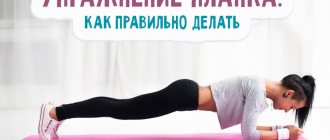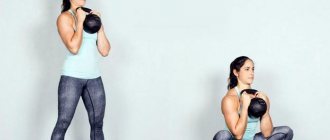Author: Timko Ilya - the ruler of the entire site and fitness trainer | more details >> Rod. 1984 Trained since 1999 Trained since 2007. Author and creator of the site tvoytrener.com. CCM in powerlifting. Champion of Russia and South Russia according to AWPC. Champion of the Krasnodar region according to IPF. 1st category in weightlifting. 2-time winner of the Krasnodar Territory championship in t/a. Author of more than 700 articles on fitness and amateur athletics. Author and co-author of 5 books.
Place in the author rating:
out of competition
(become an author) Date: 2016-12-22 Views: 138,836 Rating: 4.9
| All articles by the author >> | Medals articles >> |
Articles are loading...
| Article medals: | more than 100 thousand views |
Why medals are given to articles:
| Bronze medal: | |
| 1. The article is in the TOP 100 2. The article has more than 3. The article has more than 100 | |
| Silver medal: | |
| 1. The article is in the TOP 50 2. The article has more than 3. The article has more than 500 | |
| Gold medal: | |
| 1. The article is in the TOP 10 2. The article has more than 1 3. The article has more than 1,000 | |
This is a video article. The entire article is presented in this video. Below is just a text transcript of the video. Enjoy watching!))
General warm-up before training
It is performed first of all, warming up and preparing the entire body as a whole. Body temperature, metabolism, heart rate increases, and muscles are toned. It is usually performed for 4-6 minutes; when performing warm-up exercises, the pulse should be at the level of 130-160 beats per minute.
Types of general warm-up
- Cardio equipment: treadmills, exercise bikes, orbitracks.
- Jumping rope.
- Running in all its variations.
- Performing basic exercises with a bar or bodybar.
Proper three-step warm-up
How to do a warm-up, properly warm up your muscles and not get tired before the main workout begins? Let's take it in order.
Types of warm-ups
We can put it another way and replace “types” with stages. Because first, a general warm-up is done, and then, as the workout progresses, a warm-up is done for all muscle groups that will be loaded.
A general warm-up includes cardio and joint exercise. And warming up for specific muscle groups means working without weights or with light weights before specific exercises.
Let us now clarify how to warm up correctly and what set of exercises can be used for warming up.
Cardio - the first stage
A proper pre-workout warm-up begins with cardio.
You need to devote 5 to 20 minutes to running, an exercise bike, or an elliptical machine. You can combine exercise machines with jumping rope or other high-intensity cardio exercises.
- Fitness warm-up before weight training should be minimally energy-intensive. That is, the intense cardio part should be completed in 5–7 minutes.
- But if your goal is to lose weight, you need to run or jump longer - at least 20 minutes.
So, your pulse has risen, blood circulation has activated, the blood quickly carries oxygen and other necessary substances throughout the body.
Next, the question arises of how to warm up the muscles and joints to reduce the likelihood of injury. Let's look at the basic exercises for warming up before training.
Joints - second stage
Circular movements with different parts of the body help warm up your joints before training:
- Gently rotate your head. First, make 10 circular movements clockwise, then the same number counterclockwise. With each movement, try to increase the diameter of the circle being described.
- Pull your chin towards your chest, tilt your head as far as possible to the right and left. Repeat this movement several times.
- Place your fingers on your shoulder joints and roll your shoulders. Do these rotational movements with your arms in both directions 10 times each. Circular movements are made simultaneously with both arms bent at the elbows.
- Now you need to describe the circle several times with one and the other hand, turning your arm at the elbow.
- Then we do the same, rotating the hands at the wrists. Clench and unclench your fingers several times.
- Next, we make circular movements with the upper part of the body while standing on our feet.
- We fix the body and make circular movements with our hips, placing our hands on the belt.
- Now you can swing your legs forward and backward 10 times or squat 10 times at a pace.
- Raise your knee so that your thigh is parallel to the floor, and point your toes down. You need to draw a circle with your toe above the floor using movement in the knee joint.
- Place your toe on the floor and make rotational movements with your ankle.
Thus, we worked through all the joints sequentially from top to bottom.
There are other exercises to warm up your joints before exercise. They are done in exactly the same way, but your task will be to draw the number 8 instead of a circle. This warm-up is used in various schools of hand-to-hand combat. The effectiveness of this warm-up scheme lies in the fact that such a trajectory of movement warms up the joint much better than just a circular one.
Indeed, if you analyze this diagram, then in one exercise you perform several simple movements at once. For example, when tracing the number 8 with your head, you move your head forward, backward, right, and left. There are also circular trajectories.
How to conduct such a warm-up is exactly the same as a regular circular one. This is a very interesting way to prepare the body for training.
Warm-up at home is carried out in the same two ways: in a circle and in the figure 8.
Warm-up before training can take place in the form of outdoor active games, if we are talking about a children's sports section.
In martial arts schools, they conduct a warm-up to strengthen the body's strength and coordination resources. Such preparation allows you to warm up your muscles before training and prepare your body for good coordination.
How to make training safe? Do a basic warm-up!
Lunges with plank crunch
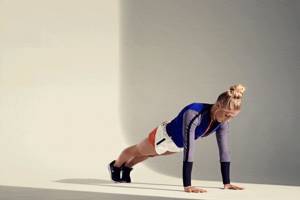
Starting position - plank with emphasis on the wrists (palms are located directly under the shoulders, the stomach is pulled in, the back is not arched, the legs, body and head form one straight line). Lunge forward with your right leg, placing your foot directly next to your right hand. Turn your body to the right and at the same time raise your right arm up so that it makes a straight line with your left arm. Stay in this position for 20 seconds. Return to the starting position and repeat the same on the other side.
Perform four repetitions, two on each side. If you lack stretching, place yoga blocks under your arms.
Try to perform all exercises very carefully, without jerking or sudden movements. Try it, and next time you will definitely want to include at least one of these options in your standard warm-up.
What are the types of warm-ups?
There are three types of warm-up: passive, general and special.
Passive warm-up
Passive warm-up includes a hot shower, heating pads, and massage. The advantage of passive warm-up is that it does not cause fatigue to the student. Unfortunately, using passive warm-up procedures may not be practical in most cases.
General warm-up
A general warm-up includes basic types of physical activity, which involve contractions of the main muscle groups. This includes running, exercises on an exercise bike, and jumping rope.
As a result of a general warm-up, heart rate, blood circulation intensity, internal body temperature, respiratory rate, joint fluid viscosity and sweating increase. Increasing muscle temperature leads to increased flexibility, which prepares the body for intense physical activity.
Special warm-up
A special warm-up, unlike a general one, includes exercises that imitate or are elements of the main part of the workout. Examples include jogging slowly before running, or chest pressing with a light weight before performing the same exercise with a training load.
A special warm-up is preferable because it allows you to increase the temperature of those muscles that will perform the work with greater load, as well as provide psychological preparation for the upcoming activity.
In rock climbing, a special warm-up includes exercises that imitate movements on a rock or stand.
Crab with change of hands
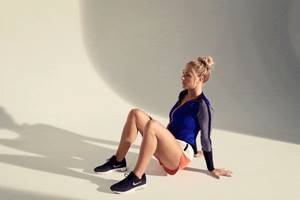
Sit on the floor, bend your knees, press your feet to the floor. Place your hands behind your back and rest them on the floor, pointing your fingers in the direction opposite to you. Lift your body up, pushing it with your hips, as if you were going to stand on a bridge, at the same time lift your right arm off the floor and extend it through your torso in the opposite direction. Lower yourself to the starting position and repeat the movement in the other direction.
Perform 16 repetitions, eight on each side. If you don't have enough mobility in your shoulder joint, simply push your body up, press your palms to the floor and hold in this position for 20 seconds.
General recommendations for warming up
- The volume, intensity and duration of the warm-up should correspond to the level of physical condition of the student.
- As your fitness level increases, you should increase the duration of your warm-up: the higher your fitness level, the more time (or greater intensity) it may take to reach your optimal body temperature.
- The lower the intensity of the movements, the longer the duration of the warm-up.
- The duration of the warm-up depends on climatic conditions. On average, the duration of the warm-up is about half an hour.
- The colder it is outside, the longer and more thoroughly you need to warm up. In winter, warm-up can last more than 40 minutes.
After which you can begin the main part of the training. And don’t forget to cool down at the end
Basic warm-up exercises
Preparatory exercises belong to the category of general developmental exercises. They do them regardless of where and what they will do: train at home, on the street or in the gym, swing or do stretching, load themselves with plyometrics or any type of fitness aerobics, run, walk with Nordic poles, ride a bike, swim .
The gold standard for starting a warm-up is a 1-2 minute cardio warm-up: light jogging and/or several intense types of walking in place.

Gymnastics for joints
The joint vortex warm-up from kung fu is considered a classic of the genre. Perform circular movements 8-16 times in each direction:
- toe (standing on one leg);
- knees closed (feet together, body tilted, palms resting on knees, you need to sit down a little while moving);
- open knees, asymmetrically inward and outward (feet shoulder-width apart, palms on knees bent at 45 degrees);
- the pelvis, and to increase the amplitude, you can “in counterbalance” use the shoulder girdle;
- shoulders;
- at the elbows, rotating the forearms in a mirror manner (arms to the sides);
- with hands or fists (arms forward or to the sides);
- head (feet shoulder width apart).
These simple movements will warm up the deep ligaments and increase the production of synovial fluid, which will protect the cartilaginous surface of the joints from deformation.

Warming up the muscles
Next to the joints, you should warm up the muscle fibers and ligaments. To do this, perform dynamic general developmental exercises, the bulk of which are turns, bends, lunges and squats.
Muscle warm-up before strength training or other type of training is designed to increase the activity of physiological systems that are responsible for muscle function and increase temperature homeostasis in them from 34 to 37.5 ° C. It should be performed until you sweat, but without fatigue. The heart rate at the end of this part of the warm-up should not exceed 130 beats/sec.
General developmental exercises are the same for all sports, but the number of exercises for a particular muscle group still depends on the work ahead. For example, before running, you should pay more attention to your legs, and before strength training for deadlifts, you should pay more attention to your back.

Stretching before exercise
Stretching is necessary not only to increase the elasticity of muscles, ligaments and tendons. It enhances the interaction of muscle fibers and improves intermuscular coordination.
Unlike the joint warm-up, where martial artists practice working the joints in the “bottom-up” direction, in stretching before training they advise “moving from head to toe.” At the same time, it is recommended to do several different ones or increase the number of repetitions of the same exercise, for parts of the body that will experience the greatest load.
The order of isometric (tension followed by stretching) warm-up:
- trapezoid - turns, tilts of the head;
- pectoralis major and minor, and then long back muscles - work at a vertical support;
- triceps;
- posterior delta bundle;
- lateral muscles of the trunk and limbs - bending to the side with raising the arm;
- short and long heads of the biceps (back surface) of the thigh;
- quadriceps;
- gluteal muscles;
- calves and Achilles tendon.
The warm-up before training in the gym ends with ballistic swings, difficult coordination jumps, and a 3-minute cardio load. After a moderate-intensity run, you need to restore your breathing, and you can start training.
Types of preparatory gymnastics
Preparatory exercises can be intended for people of varying physical fitness, so everyone should choose the exercise that suits them.
General charging
It includes exercises with gradual kneading of the muscles of the neck, shoulders, chest, arm muscles, waist and hips. This part of the lesson should last approximately 15 minutes. At the same time, be sure to warm up the muscles of the shoulders, arms, knees and ankles. The lesson is also complemented by cardio training, for example, jumping rope, running in place, and so on.
Special program
This workout is designed to stretch specific muscles in the body. The program must be completed before strength training. The weight of dumbbells should be 20% of their bulk during training. There should be no more than 10 approaches . It is also necessary to stretch the calf ligaments, back muscles and hips. Warming up before strength training will help prepare your muscles for the heavier weight of the dumbbells.
Warm-up for the hips
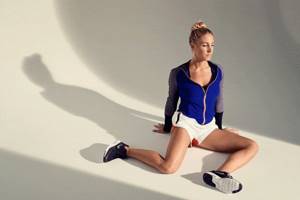
Sit on the floor, bend both knees at an angle of 90 degrees and point to the left side, place your hands behind your hips. From this position, lift both knees up. Without lifting your feet from the floor, turn in the other direction through the center and place your feet on the floor. Perform 16 of these repetitions, eight on each side.
If you can't do a full rotation, hold each side with your hips turned out on the floor for 30 seconds.
Dead beetle
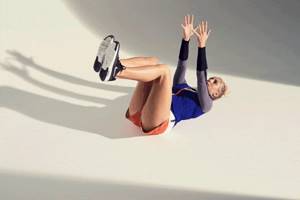
Lie on the floor, stretch your arms in front of you, bend your knees at an angle of 90 degrees. Press your shoulders to the floor, relax your feet. Tighten your abs, press your lower back to the mat, extend your right arm and left leg without touching the floor. Then return to the starting position and repeat the movement, changing arms and legs.
Perform 16 full repetitions. If you find it difficult to control your body, leave your arms in the original position and straighten only your legs one at a time. Add your arms when you feel you have enough strength to do so.
